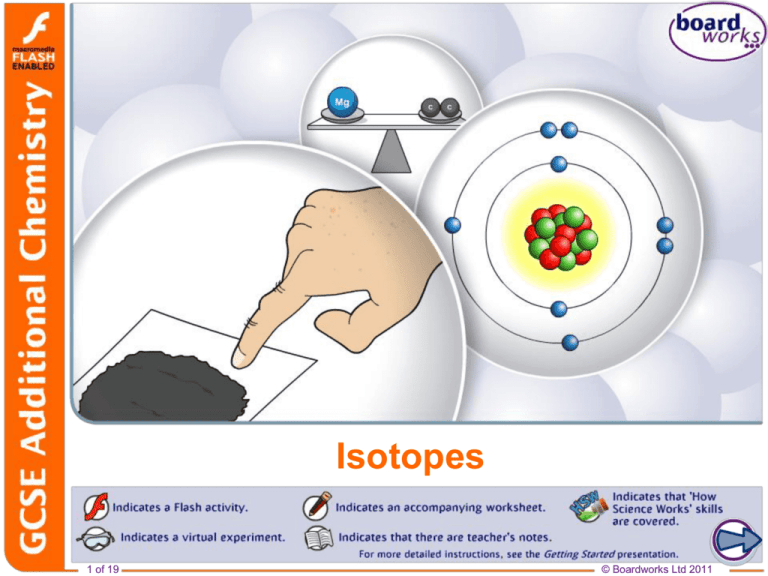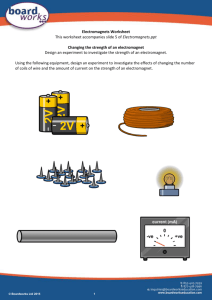Isotopes: Chemistry Presentation for High School Students
advertisement

Isotopes 1 of 19 © Boardworks Ltd 2011 2 of 19 © Boardworks Ltd 2011 Atomic structure revision 3 of 19 © Boardworks Ltd 2011 Atomic structure revision Sodium (Na) can form an Na+ ion. How many protons, electrons and neutrons does Na+ have? Use the tile from the periodic table below to help you. 11 protons 12 neutrons 10 electrons Na+ has a charge of +1 because it has lost one electron, and has one more proton than electrons. 4 of 19 © Boardworks Ltd 2011 What is an isotope? Elements are made up of one type of atom, but the atoms of an element can come in slightly different forms. Although atoms of the same element always have the same number of protons, they may have different numbers of neutrons. Atoms that differ in this way are called isotopes. For example, two isotopes of carbon: mass number is different atomic number is the same 5 of 19 © Boardworks Ltd 2011 What are the isotopes of carbon? Most naturally-occurring carbon exists as carbon-12, about 1% is carbon-13 and a much smaller amount is carbon-14. 6 protons 6 neutrons 6 electrons 6 of 19 6 protons 7 neutrons 6 electrons 6 protons 8 neutrons 6 electrons © Boardworks Ltd 2011 Properties of isotopes The isotopes of an element are virtually identical in their chemical reactions. This is because they all have the same number of protons and the same number of electrons. The uncharged neutrons make little difference to chemical properties, but do affect physical properties such as melting point and density. Natural samples of elements are often a mixture of isotopes. 7 of 19 © Boardworks Ltd 2011 What are the isotopes of hydrogen? Hydrogen-1 makes up the vast majority of the naturallyoccurring element, but two other isotopes exist. hydrogen 1 proton 0 neutrons 1 electron 8 of 19 deuterium 1 proton 1 neutron 1 electron tritium 1 proton 2 neutrons 1 electron © Boardworks Ltd 2011 What are the isotopes of chlorine? About 75% of naturally-occurring chlorine is chlorine-35, and 25% is chlorine-37. 9 of 19 17 protons 17 protons 18 neutrons 20 neutrons 17 electrons 17 electrons © Boardworks Ltd 2011 What are the isotopes of oxygen? Almost all naturally-occurring oxygen is oxygen-16, but about 0.2% is oxygen-18. What are the particle numbers in each isotope below? oxygen-16 8 protons 8 neutrons 8 electrons oxygen-18 8 protons 10 neutrons 8 electrons 10 of 19 © Boardworks Ltd 2011 Isotopes – true of false? 11 of 19 © Boardworks Ltd 2011 12 of 19 © Boardworks Ltd 2011 What is relative atomic mass? 13 of 19 © Boardworks Ltd 2011 Where are r.a.m. values found? The values of relative atomic mass (r.a.m.) are usually given in a data book or found in the periodic table, so you don’t have to work them out or remember them all! relative atomic mass symbol atomic number When looking up r.a.m in the periodic table, remember that it is always the larger of the two numbers given. 14 of 19 © Boardworks Ltd 2011 Why isn’t r.a.m. always a whole number? Relative atomic mass (r.a.m.) is not always a whole number. For example, the r.a.m. of chlorine is 35.5. The standard r.a.m. value of each element is actually the average relative atomic mass, which takes all the isotopes of each element into account. Chlorine has two isotopes: chlorine-35 (75%) and chlorine-37 (25%). average r.a.m. of chlorine 15 of 19 = (35 × 75%) + (37 × 25%) = (35 × 0.75) + (37 × 0.25) = 26.25 + 9.25 = 35.5 © Boardworks Ltd 2011 Calculating average r.a.m. from isotopes To calculate the average r.a.m. of a mixture of isotopes, multiply the percentage of each isotope by its relative atomic mass and then add these together. Naturally-occurring bromine is composed of two isotopes: bromine-79 (50.5%) and bromine-81 (49.5%). What is the average r.a.m. of naturally-occurring bromine? average r.a.m. = (79 × 50.5%) + (81 × 49.5%) = (79 × 0.505) + (81 × 0.495) = 39.895 + 40.095 = 79.99 This figure can be rounded up. 16 of 19 © Boardworks Ltd 2011 17 of 19 © Boardworks Ltd 2011 Glossary 18 of 19 © Boardworks Ltd 2011 Multiple-choice quiz 19 of 19 © Boardworks Ltd 2011




